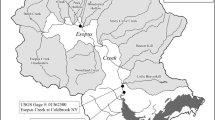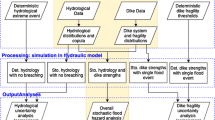Abstract
Terrestrial sediments transported off disturbed watersheds can threaten downstream estuarine and coastal environments. Practitioners in the field of environmental management need to be able to assess how activities that disturb the land are likely to impact on downstream estuarine and coastal receiving waters. Such assessments usually take the form of estimating risk, which has two components: the extent of undesirable consequences and the probability of occurrence of those consequences. The consequence in this case is primarily the ecological damage. In order to estimate risk, a methodology was developed around the use of a deterministic computational model of watershed/estuarine sediment transport. Model simulations are run which cover the physically realistic range of the controlling variables (e.g., wind speed, wind direction, sediment runoff). The model results are related to estuary damage and combined with the probability of occurrence for each scenario, providing a means of quantifying risk. In addition, answers to `long-term average', `most likely' and `worse case' type questions can be made. The procedure has the advantages of being easily implemented, transparent and repeatable. It is also more efficient than a standard Monte-Carlo procedure. The risk associated with changes in landuse can be examined without repeating model simulations. The example used to illustrate the method is that of a developing watershed in which proposed building activities are expected to alter the sediment yield to the downstream estuary during floods, which in turn is expected to smother shellfish beds. By elucidating risk associated with each development scenario, the management debate can be focused on choice of an acceptable risk level.
Similar content being viewed by others
References
Bottcher, A. B., N. B. Pickering, B. M. Jacobson, J. G. Hiscock & R. T. Hilburn, 1998. WAM: Watershed Assessment Model for Complex Landscapes. 1st Int. Conf of Geospatial Information in Agriculture and Forestry. Orlando, Florida, June 1-3, 1998.
Black, K. P., M. O. Green, T. Healy, R. G. Bell, J. Oldman & T. M. Hume, 1999. Lagrangian modelling techniques simulating wave and sediment dynamics determining sand-body equilibria. In Harff, J., W. Lemke & K. Stattegger (eds), Computerized Modelling of Sedimentary Systems. Springer-Verlag, Berlin: 3-21. (First presented at the Int. Sym. Computerized Modelling of Sedimentary Systems, Güstrow, Germany, October 1996.)
Hertz, D. B. & H. Thomas, 1983. Risk Analysis and its Applications. John Wiley and Sons, New York.
Megill, R. E., 1985. An Introduction to Risk Analysis. 2nd edn. PennWell Books, Tulsa, OK.
Norkko, A., S. F. Thrush, V. J. Cummings, J. E. Hewitt, J. Genberg, J. I. Ellis, G. A. Funnell & D. Schultz, 1999. Ecological effects of sediment deposition. In Cooper, B., M. Green & S. Thrush (eds), Sediment Impacts on Estuarine Ecosystems - An Approach to Risk Assessment, Okura estuary. In Proc. First South Pacific Conference on Comprehensive Stormwater & Aquatic Ecosystem Management, Auckland, New Zealand, February 1999: 75-98.
Pearson, C. P., 1992. Analysis of floods and low flows. In Mosley, M. P. (ed.), Waters of New Zealand. New Zealand Hydrological Society Inc, Wellington, NZ: 99-102.
Soulsby, R. L., 1997. Dynamics of Marine Sands - A Manual for Practical Applications. Thomas Telford Publications Ltd, London, U.K.: 216 pp.
Swales, A., R. B. Williamson, L. F. Van Dam, M. J. Stroud & M. S. McGlone, 2002. Reconstruction of urban stormwater contamination of an estuary using catchment history and sediment profile dating. Estuaries 25: 43-56.
Author information
Authors and Affiliations
Rights and permissions
About this article
Cite this article
Senior, A., Green, M. & Oldman, J. Using deterministic models to assess risk in sediment-impacted estuaries. Hydrobiologia 494, 11–16 (2003). https://doi.org/10.1023/A:1025464820912
Issue Date:
DOI: https://doi.org/10.1023/A:1025464820912




